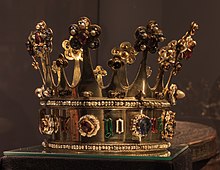Aachen miraculous image
The Aachen miraculous image is a traditional figure of Mary with a child in Aachen Cathedral .
History and tradition
The worship of this miraculous image has a centuries-old tradition in Aachen. It is sometimes assumed that a statue of the Virgin Mary has been highly venerated in Aachen for almost a thousand years. Seals from the 13th century have been preserved, depicting a queen of heaven seated on a throne with a blessing child Jesus with the inscription SANCTA MARIA AQUENSIS . Assumptions date the depicted statue to the 10th century.
The oldest attested figure is a Gothic oak figure from the 14th century. It burned almost completely in the town fire in 1656. The rescued heads and the right hand of Mary were integrated into a new figure made of linden wood. The ashes of the burned figure were placed in a cavity in the back. This figure was completely restored in 1987. She was endangered by wood beetle infestation, fingertips and Maria's little finger were already missing.
Clothes and treasure of the image of grace
The two figures - Maria and the child - have been wearing changing textile garments since the 15th century at the latest. It is a tradition in Aachen that the Mother of God is given clothes and other pieces of jewelry - often on special occasions. The oldest evidence of this tradition - and at the same time one of the most valuable pieces of the miraculous image - is the crown of Margaret of York from 1461, which she gave to the miraculous image in 1474.
To this day, clothes and jewelry are given to the figure of the Virgin Mary, as thanks for passing an exam, as an intercession for survival in war or for other reasons. Earrings, pocket watches, perfume bottles and smaller gold bars were also bequeathed to her.
About a dozen times a year, the image of grace is dressed in a different robe, so that one rarely goes to the cathedral and Mary wears the same dress. In 2007 Maria had 41 dresses and "several 100" pieces of jewelry.
Selection of the pieces given to the image of grace

-
The wedding crown of Magareta of York around 1461
was worn by her in 1468 when she married Charles the Bold . The only surviving English royal crown from the Middle Ages.
Mary only wears this crown every seven years on her journey to the shrine . - Robe from the 16th century , the oldest surviving garment of the miraculous image. It can no longer be used due to its state of preservation.
- The robe of the Infanta Isabella Clara Eugenia , a dress set with diamonds and freshwater pearls, donated in 1629 by the Spanish Infanta Isabella Clara Eugenia . This garment is also only used to travel to the shrine.
Trivia
- In popular parlance, Maria is also referred to as the “richest woman in Aachen” because of the many presents. Another rumor circulating in Aachen that Maria is just an untreated block of wood in clothes is unfounded.
- When a replacement statue was erected in the cathedral during the restoration in 1987, the cathedral chapter received a letter stating that the new Madonna was beautiful, "but it does not work, one cannot pray in front of it."
- Anyone who would like to give Maria a dress would do well to coordinate with the cathedral beforehand. There are “gorgeous” clothes that Maria cannot wear because they simply do not suit her. You can also get patterns from the cathedral staff.
- The importance of the miraculous image also shows its occurrence in legends. It is reported from Saint Gezelinus from today's Leverkusen that an angel guarded the flock of the shepherd Gezelinus so that he could make a pilgrimage to the image of grace in Aachen.
Individual evidence
- ^ Journal of the Aachen History Association , thirtieth volume, Aachen 1908
- ↑ Christoph Stender treasure views
- ↑ a b c d e f The fashion fan can get jealous . Aachen News December 23, 2007
- ^ Georg Minkenberg : On the Isabella Clara Eugenia Foundations, Aachen Cathedral Chapter, 1987
- ↑ Exhibition: Mouse comes to extraordinary honors Aachener Zeitung May 1st, 2015
- ↑ Legend of St. Gezelinus ( Memento of the original from May 17, 2016 in the Internet Archive ) Info: The archive link was inserted automatically and has not yet been checked. Please check the original and archive link according to the instructions and then remove this notice. Website of St. Andreas in Schlebusch in the Archdiocese of Cologne
